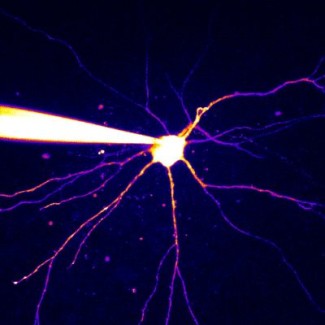
PhD, Team Leader, PI, CNRS
Team presentation
The team’s objective is to understand how the diversity of biophysical properties and the synaptic density of NMDA receptors influence the dendritic integration of S1 neurons and thus their role in processing sensory information.
Using state-of-the-art in vitro and in vivo electrophysiology and calcium imaging techniques, the team’s goals are:
- To estimate the functional role of NMDA receptor diversity in cortical glutamine neurons
- To study the effect of these receptors on signal processing by cortical interneurons
- To identify a relationship between endogenous NMDA receptor modulators and their diversity.
Clinical neurophysiology is a specialty that studies the nervous system through the recording of bioelectrical activities.
Neurons are cells that can be excited: in response to stimulation, the nerve fibre produces an electrical signal, the building block of nerve input, the action potential (AP). Neurons are composed of a cell body and two types of extensions: dendrites that carry the nerve message to the cell body of the neuron and an axon that carries the nerve message to a response effector cell or to a synapse, the area of communication between two neurons.
Main publications
- Rebola N, Reva M, Kirizs T, Szoboszlay M, Lorincz A, Moneron G, Nusser Z, DiGregorio DA, Distinct Nanoscale Calcium Channel and Synaptic Vesicle Topographies Contribute to the Diversity of Synaptic Function. Neuron 2019, (in press)
- Carta, M., Srikumar, S.N, Gorlewicz, A., Rebola, N* and Mulle C* Activity-dependent control of NMDA receptor subunit composition at hippocampal mossy fiber synapses. J. Physiol (*-Co-last authors)
- Rebola N, Carta M, Mulle C, Operation and plasticity of hippocampal CA3 circuits: implications for memory encoding. Nat, Rev. Neurosci. 2017 Apr;18(4):208-220.
- Vergnano AM*, Rebola N*, Savtchenko L*, Casado M, Kieffer B, Rusakov D, Mulle C and Paoletti P, Zinc dynamics and action at excitatory synapses, Neuron 2014, 82(5):1101-14. *-Co-first authors
- Carta M*, Lanore F*, Rebola N*, Szabo Z, Viana Da Silva S, Lourenço J, Verraes A, Nadler A, Schultz C, Blanchet C, Mulle, C. Membrane lipids tune synaptic transmission by direct modulation of presynaptic potassium channels, Neuron. 2014, 81(4):787-99. *-Co-first authors
- Rebola N, Carta M, Lanore F, Blanchet C, Mulle C. NMDA receptor-dependent metaplasticity at hippocampal mossy fiber synapses. Nature Neurosci. 2011Jun.;14(6):691–3.
- Rebola N, Luján R, Cunha RA, Mulle C. Adenosine A2A Receptors Are Essential for Long-Term Potentiation of NMDA-EPSCs at Hippocampal Mossy Fiber Synapses. Neuron. 2008 Jan.;57(1):121–34.
- Marvin JS, Scholl B, Wilson DE, Podgorski K, Kazemipour A, Müller JA, Schoch S, Quiroz FJU, Rebola N, Bao H, Little JP, Tkachuk AN, Cai E, Hantman AW, Wang SS, DePiero VJ, Borghuis BG, Chapman ER, Dietrich D, DiGregorio DA, Fitzpatrick D, Looger LL. Stability, affinity, and chromatic variants of the glutamate sensor iGluSnFR. Nat Methods. 2018 Nov;15(11):936-939


